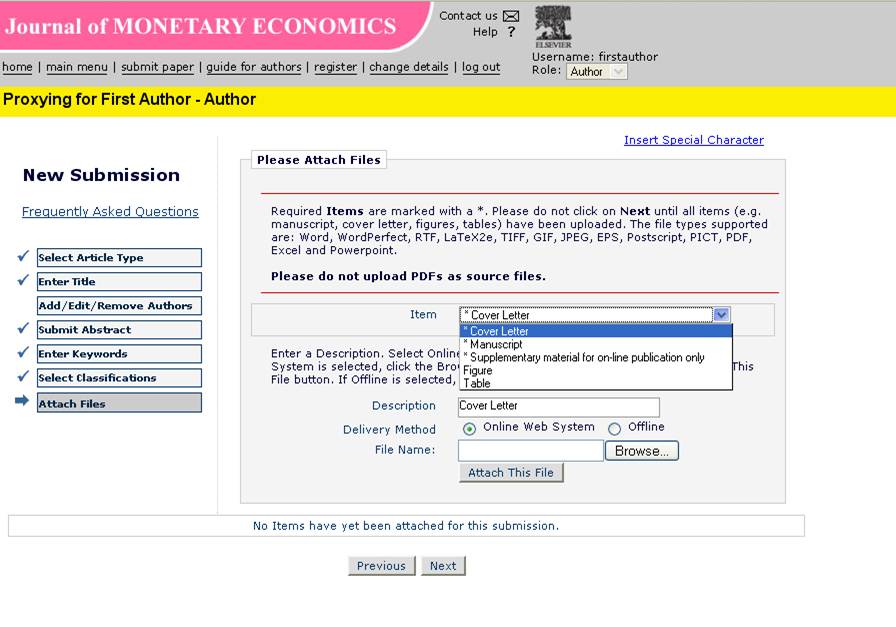Supplemental materials for Journal of Monetary Economics articles in
ScienceDirect — Elsevier’s online distribution system for articles from JME and other journals — can be used to make supplementary materials available to interested readers. (Examples are provided by the two Journal of Public Economics articles cited below). These elements include:
- appendices containing details of proofs, explanations of data sources, and details of computational algorithms;
- computer programs;
- data files;
- further explorations of topics studied in the published paper such as elaboration of theoretical models, robustness analysis of empirical specifications, or additional computational experiments.
The Journal of Monetary Economics has the following policies with respect to these supplemental materials.
First, an editor may require the provision of supplemental materials (such as proofs, data sets, or computational programs) as a condition of publication. The editor may ask an author to prepare drafts of these supplemental materials and submit them along with a revised manuscript (as part of a “revise and resubmit” decision or one of the various acceptance decision).
Second, it is the author’s responsibility to make sure that:
- the main paper can be read and understood without reference to the supplementary materials
- the supplementary materials are clearly written and readily used by an individual that downloads one or more of these components.
Third, while the JME encourages the provision of supplementary materials, it does not review them with the same detail as the core paper. Users are expected to communicate directly with the author about supplemental materials, not with the editor. No comments on or criticisms of supplemental materials will be considered for publication.
Fourth, while the JME encourages the provision of supplementary materials via Science Direct, authors may additionally distribute these materials via their own websites or collective groups such as REPEC.
Submission of supplemental materials: Authors may submit supplemental materials to the EES system along with the main paper, just as they can separately submit other items. Please see the discussion “mechanics of entering supplementary files” below.
Elsevier has prepared some author instructions that should be reviewed prior to submitting supplementary files:
For supplementary artwork, please refer to www.elsevier.com/artwork
Please note that .zip files are acceptable as a format for supplements (see http://www.elsevier.com/wps/find/authorsview.authors/archives_multimedia for instructions on zip files and other archive formats)
Please note that Elsevier’s recommended upper limit for a single supplementary file is 10MB; this limit is mainly in place to limit the time it takes to open the file.
| Examples from Journal of Public Economics |
| Kevin Milligan and Mark Stabile, The integration of child tax credits and welfare: Evidence from the Canadian National Child Benefit program, Journal of Public Economics, Volume 91, Issues 1-2, , February 2007, Pages 305-326. (http://www.sciencedirect.com/science/article/B6V76-4KCGHS9-2/2/6052a6f79728d7ff150b2f1ff2b2ba40) |
| Ramon Lopez and Gregmar I. Galinato, Should governments stop subsidies to private goods? Evidence from rural Latin America, Journal of Public Economics, Volume 91, Issues 5-6, , June 2007, Pages 1071-1094.(http://www.sciencedirect.com/science/article/B6V76-4MJRYYD-1/2/87d7578619b7873746ef4d9abc049078) |
Mechanics of entering supplementary files: One enters supplementary files at the same “attach files” stage at which one enters the cover letter and the manuscript files within the EES system. The figure below shows this way that the EES page should appear to an author submitting a manuscript.
Labeling
Authors should label each submitted supplementary material file very clearly. For example, a manuscript that included all of the above items should have separate supplementary material files labeled as
- Supplementary materials: details of proofs
- Supplementary materials: computer programs
- Supplementary materials: data files
- Supplementary materials: extensions, further explorations, and robustness of results
